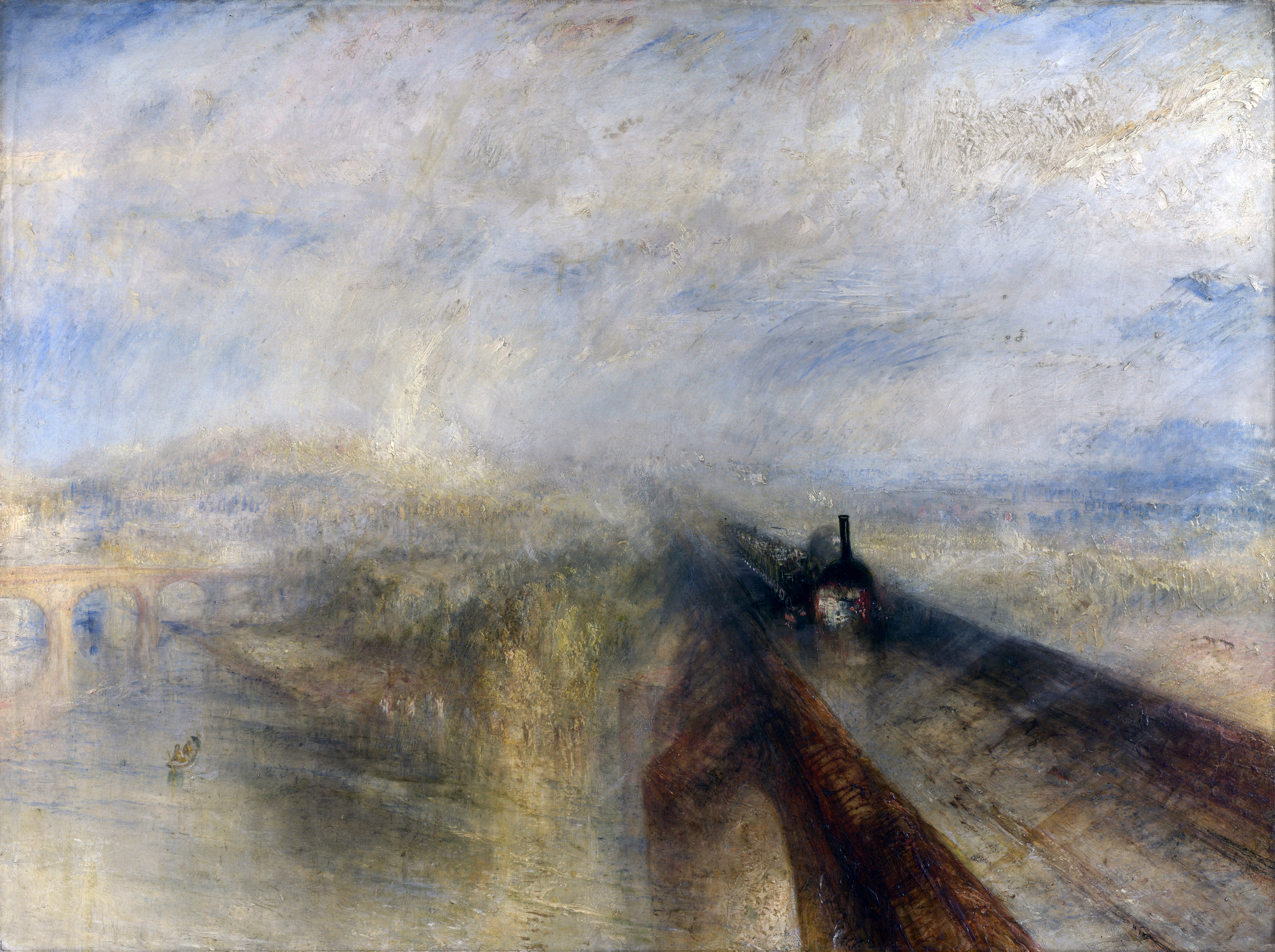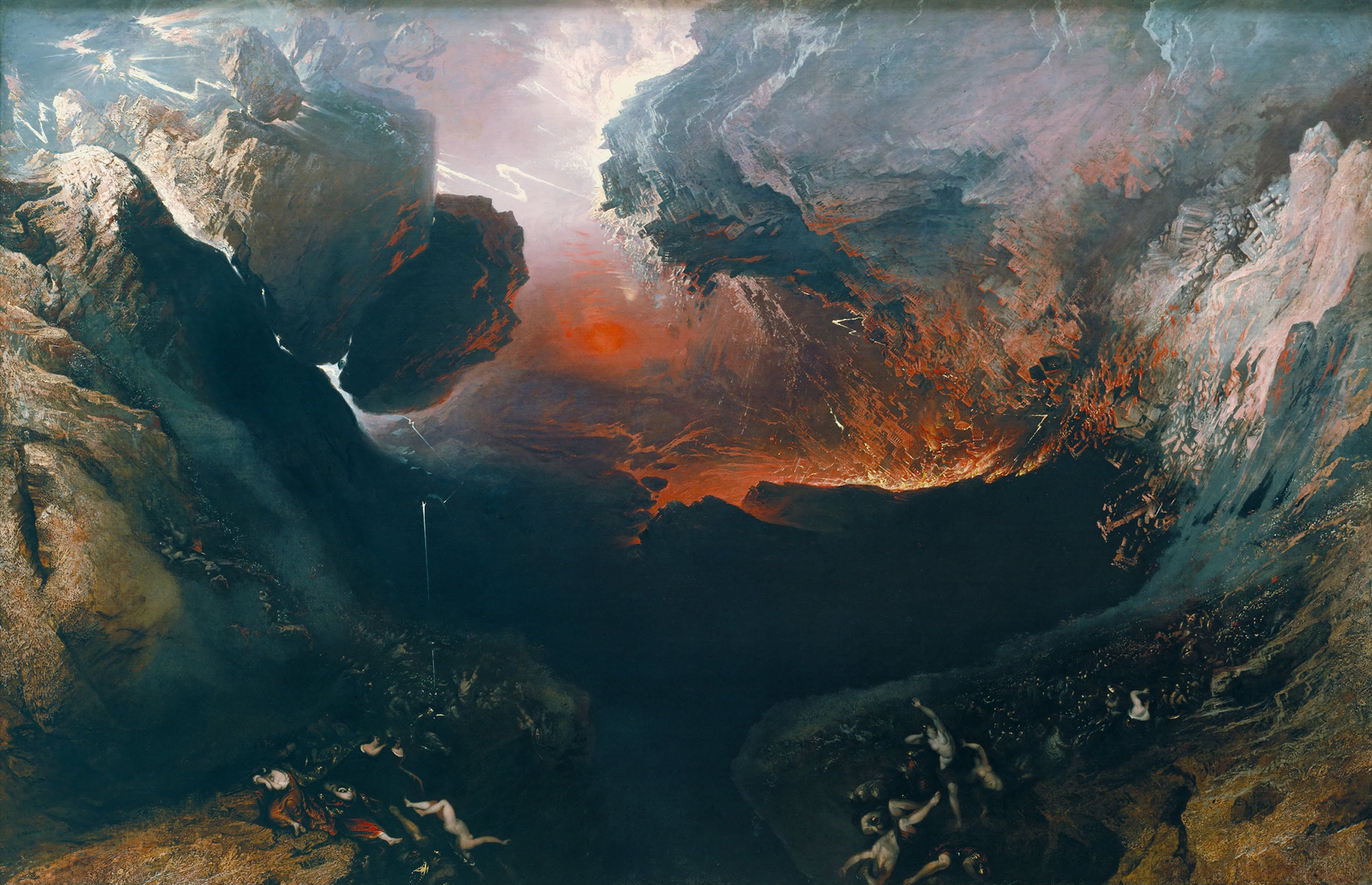There were a lot of scientific discoveries which lead people to forget God, art etc. Is science killing God? was the question Joseph Wright is asking his viewers in his painting An Experiment on a Bird in the Air Pump (1768). It is an image of a philosopher showing to a family how the bird will die from the lack of oxigen in the air pump. The gothic in this painting is not, in fact, the bird dying but the gloomy sky that we can see through the window (on the right). He was also the first artist to paint a factory. The lights in the factory were turned on which showed how people were working night and day, even children.
The Ghost of a Flea (c. 1891-1820) is a painting by William Blake, an english poet and painter. His inspiration for the image was a microscopic image of a flea, but the painting showed a weird monsterous creature. Blake was strongly against science and he said that art is the tree of life, science is the tree of death.
People who shared Blake's and Wright's way of thinking began to question who we are. This lead to Mesmerism. It was a therapeutic system invented by Franz A. Mesmer in late 18th century. Basically, it was a form of hypnotism, which was very gothic at the time.
Other artists that have created paintings with gothic elements were Joseph M. W. Turner and John Martin. J.M.W. Turner painting; Rain, Steam and Speed – The Great Western Railway (1844) was gothic as it showing how the land went from rural to industrial in just a few decades. A Great Day of His Wrath (c. 1851-1853), painted by John Martin, is a depiction of the end of the world. Martin predicted the worse that could happen and that is why the painting was so popular.

An Experiment on a Bird in the Air Pump
National Portrait Gallery
Oil on canvas
1768
Artist: Joseph Wright
(source: http://www.treccani.it/scuola/lezioni/fisica/deformazioni)

The Ghost of a Flea
Tate Britain, London
Tempera mixture panel with gold on mahagony
c. 1819-1820
Artist: William Blake
(source: http://en.wikipedia.org/wiki/The_Ghost_of_a_Flea)



Albert Memorial
Kensington Gardens, London
Unknown photographer
(source: http://www.paesionline.it/europa/gran_bretagna_londra/monumenti_ed_edifici_storici/albert_memorial.asp)

The Ghost of a Flea
Tate Britain, London
Tempera mixture panel with gold on mahagony
c. 1819-1820
Artist: William Blake
(source: http://en.wikipedia.org/wiki/The_Ghost_of_a_Flea)

Rain, Steam and Speed – The Great Western Railway
in National Gallery, London
in National Gallery, London
Oil on canvas
1844
Artist: J.M.W. Turner
(source: http://en.wikipedia.org/wiki/Rain,_Steam_and_Speed_%E2%80%93_The_Great_Western_Railway)

A Great Day of His Wrath
Tate Britain, London
Oil on canvas
c. 1851-1853
Artist: John Martin
(source: http://en.wikipedia.org/wiki/The_Great_Day_of_His_Wrath)
Moving on to literature, influenced by the industrial revolution and science, in 1818 Mary Shelley published a gothic novel Frankenstein. She stayed anonymous, until the publication of the second edition in 1823. A scientist, Victor Frankenstein, created a creature from decaying body parts. Shelley tried to warn the society that science might run out of control and that they should think about the consequences, before creating something big. Shelley was a graveyard poet, too.
Writers came to the realization that the most haunted place is the human mind and the greatest terror is not knowing yourself (in connection to mesmorism). Some of the greatest writers in the history such as Byron, Coleridge and Keats turned to drugs and alcohol to explore their own minds. By taking opiums they could get inspiration and explore their darkest gothic fantasies. Thomas De Quincey wrote The confessions of an english opium-eater, a gothic novel from his own personal experience. The story is a warning of that can happen under the influence of drugs. To De Quincey, opium was an escape from his own unhappiness, and by taking a drug he would take a trip in his mind. A mind on drugs = gothic.
Industrial revolution was followed by industrial trauma and the city became a source of many fears which lead to urban horror; Penny dreadful stories. Penny dreadful stories were short serial stories about the city, crime, poverty etc., and cost 1 penny. Most popular were Varney the Vampire, Sweeney Todd and Spring Heeled Jack.
Charles Dickens reinvented the urban gothic horror for middle classes. His novels were not as much about the supernatural, but about the gloom of the industrial world (London - great gothic castle). Dickens tried to show the society how they don't have to read about gothic horror, they are living in it.
Through art and literature we can see how society started to fall apart. There was nostalgia for the od middle ages and people wanted to go back to when everything was better. That was when gothic optimists came along. The nation would play act being medieval by organizing tournaments (1839. first tournament in years) and balls in the Buckingham palace - it was a way of escaping the present.
Of course, this influenced the literature and architecture. Sir Walter Scott published a historical romance novel in 1820; Ivanhoe which was about England in the 12th century. The most influential book of the time is Contrast by Augustus Pugin. He compared modern architecture with gothic, showing why modern is bad and gothic is good. Pugin was an architect and after the houses of parliament burnt down, in 1838 he designed it in gothic style. He built many chappells, cathedrals, schools and houses and, unfortunatelly, died at the age of 40.
Queen Victoria (Widdow of Windsor) built the Albert Memorial in her memory of her husband Albert. The memorial is located in Kensington Gardens in London and built in gothic revival style. I have already mentioned her 40-year-long mourning period, as well as gothic revival in my older posts, but haven't included the Albert Memorial in my research.
Writers came to the realization that the most haunted place is the human mind and the greatest terror is not knowing yourself (in connection to mesmorism). Some of the greatest writers in the history such as Byron, Coleridge and Keats turned to drugs and alcohol to explore their own minds. By taking opiums they could get inspiration and explore their darkest gothic fantasies. Thomas De Quincey wrote The confessions of an english opium-eater, a gothic novel from his own personal experience. The story is a warning of that can happen under the influence of drugs. To De Quincey, opium was an escape from his own unhappiness, and by taking a drug he would take a trip in his mind. A mind on drugs = gothic.
Industrial revolution was followed by industrial trauma and the city became a source of many fears which lead to urban horror; Penny dreadful stories. Penny dreadful stories were short serial stories about the city, crime, poverty etc., and cost 1 penny. Most popular were Varney the Vampire, Sweeney Todd and Spring Heeled Jack.
Charles Dickens reinvented the urban gothic horror for middle classes. His novels were not as much about the supernatural, but about the gloom of the industrial world (London - great gothic castle). Dickens tried to show the society how they don't have to read about gothic horror, they are living in it.
Through art and literature we can see how society started to fall apart. There was nostalgia for the od middle ages and people wanted to go back to when everything was better. That was when gothic optimists came along. The nation would play act being medieval by organizing tournaments (1839. first tournament in years) and balls in the Buckingham palace - it was a way of escaping the present.
Of course, this influenced the literature and architecture. Sir Walter Scott published a historical romance novel in 1820; Ivanhoe which was about England in the 12th century. The most influential book of the time is Contrast by Augustus Pugin. He compared modern architecture with gothic, showing why modern is bad and gothic is good. Pugin was an architect and after the houses of parliament burnt down, in 1838 he designed it in gothic style. He built many chappells, cathedrals, schools and houses and, unfortunatelly, died at the age of 40.
Queen Victoria (Widdow of Windsor) built the Albert Memorial in her memory of her husband Albert. The memorial is located in Kensington Gardens in London and built in gothic revival style. I have already mentioned her 40-year-long mourning period, as well as gothic revival in my older posts, but haven't included the Albert Memorial in my research.

Albert Memorial
Kensington Gardens, London
Unknown photographer
(source: http://www.paesionline.it/europa/gran_bretagna_londra/monumenti_ed_edifici_storici/albert_memorial.asp)
This episode was, in my opinion, a lot more interesting than the first one. The reason is probably that this episode was more connected with our brief. I have already researched some facts Dixon mentioned, but it was interesting to see and hear his research. There is always something new to learn and I wish I watched this episode before writing some of my posts.
reference found on March 8th 2015
Nema komentara:
Objavi komentar